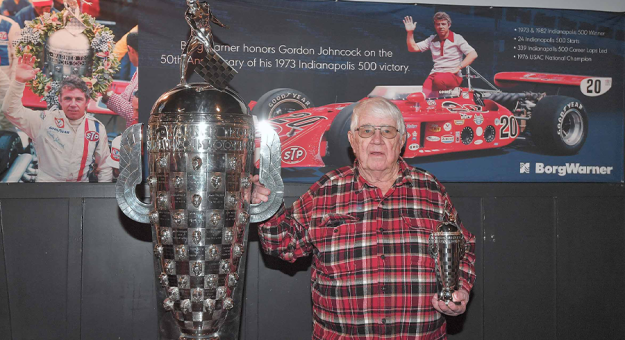INDIANAPOLIS — During his era, there was no driver who raced harder than Gordon Johncock.
The Hastings, Mich., native had the foot of an elephant on the accelerator and that style carried him to Indianapolis 500 wins in 1973 and 1982. He won 25 IndyCar races from 1965 to 1983 and finished second or third 51 times.
Johncock started 24 Indianapolis 500s and led seven races for 339 laps. He also won the 1976 USAC National Championship in Indy cars.
Fifty years after winning the 1973 Indianapolis 500, the 86-year-old Johncock received his retro Baby Borg for his outstanding racing career.
His entire family including his wife, Sue, his sons and daughters and in-laws and grandchildren and great grandchildren as well as many of the crewmembers from his 1973 and 1982 Indy 500 victories attended a special ceremony for Johncock presented by BorgWarner at Binkley’s Kitchen and Tavern in the Broad Ripple section of Indianapolis on Monday afternoon.
It was preceded by a tour of the Indianapolis Motor Speedway and the Indianapolis Motor Speedway Museum.
Johncock even drove one of the IMS Museum Tour Busses around the 2.5-mile oval.
Plaques were given former winners until 1988 until Rick Mears came up with the idea for Baby Borgs to go to the winner. On milestone anniversaries, past winners have received a Baby Borg.
Indianapolis 500 winners Parnelli Jones, Bobby Unser, A.J. Foyt, Mario Andretti and Al Unser have all received Baby Borgs on the 50th anniversary of their first wins.

“This is really something very special,” Michelle Collins, global director of marketing and public Relations for BorgWarner said.” Every day, I’m dealing with a lot of other things with corporate America, buying and selling companies, a lot of different things. This is the most exciting, by far.
“To continue this tradition of drivers who have been able to celebrate the 50th anniversary of their win is very special. This was really Steve Shunck’s brainchild, and he really admires Gordon Johncock. I’m happy to support it any way I can.”
With that, one of the greatest racers in Indianapolis 500 history accepted the Baby Borg, wearing his famous flannel shirt and blue jeans.
“Steve Shunck (BorgWarner publicist) said this morning I was going to talk for a half hour or 45 minutes, I don’t know what he was smoking or drinking,” Johncock quipped. “I done most of my talking with a steering wheel. As most people know, I wasn’t very good at making appearances and stuff I didn’t really like to do. I was farming and doing different things up north. When I got done racing, I got on an airplane or a car and went home and went to work. That is what I was really caring to do.
“Racing has really been good to me. With the help of a lot of people, no one person does it themselves. I don’t care if it’s baseball or football or basketball, along the way you have had help from a lot of people. One person can’t do it by themselves. They have to have help. They have all done a lot to put this together and I want to thank them very much and everybody for participating in this event.
“We had breakfast the other day with my crew, and it was great to see all of the guys.”
Crew members including 1982 crew chief George Huening, crew members John Anderson, Larry Faust, Bones Breiton and others were reunited to the driver who won one of the most dramatic Indianapolis 500s in history in his 1982 duel with Rick Mears.
At that time, it was the closest Indianapolis 500 in history with the margin of victory .16 seconds.
Today, it is the fifth-closest finish in Indy 500 history in any race that did not finish under caution. The 1992 finish now ranks as the closest with Al Unser Jr. .043 seconds ahead of Scott Goodyear.
The 1982 finish was the first time in Indianapolis 500 history that anyone had ever seen such a fierce fight to the checkered flag. It remains the standard to which all Indianapolis 500s since then have been measured.
“By far the biggest thrill of my racing career was winning Indianapolis in 1982,” Johncock recalled. “The way it happened, the competition, so many near wins after 1973 and it all came together, and the car lasted in 1982.
“Plus, I’ve got amazing respect for Rick Mears — one of the very best. He was never my teammate, but I think we could have been good ones,” Johncock continued. “I think the more pressure that was on me during a race the better I did and with the car pushing so bad and Rick on my tail it was great. I’ll never forget it. There are so many memories from that day — the crazy start, my final pit stop and winning by such a narrow margin — pushing so hard the final laps with Rick in my mirrors.”

At that time, there was no speed limit on pit lane and on Johncock’s final pit stop of the race, he came flying down a very bumpy pit lane for the pit stop that kept him ahead of Mears, setting up the dramatic fight to the finish.
“I really benefitted from no pit speed limit at Indianapolis,” Johncock said. “I could come into the pits off turn four wide open and never let off until I was actually on pit road. I was probably going 190 mph.
“But that was racing back then and you had to go 100 percent wherever you could. You never really thought about it — you just kept your foot down as long as you could and slowed to hit your marks.”
His most dominant performance in the Indianapolis 500, however, came in 1977 when he led 129 laps before his engine blew up while leading A.J. Foyt with 16 laps remaining.
“The 1977 500 was the biggest disappointment of my life — the biggest,” Johncock said. “With 16 laps to go I was leading A.J. — he was 13 or so seconds behind me. I was running so smooth and easy then coming out of four the crankshaft breaks, I pulled over in the turn-one grass, got out of the car and laid down in the creek.
“We had it won. A.J. would have never caught me. He would have never caught me. Boy, oh boy, I’m still disappointed.”
Johncock likely does not get the credit he deserves for his 1973 Indianapolis 500 win because of the grim circumstances that surrounded that month of May.
There were three fatalities, including popular driver Art Pollard, who was killed in the final Saturday morning practice before Pole Day Qualifications. Johncock’s teammate was Swede Savage, who was in a horrifying crash in turn four. He died from his injuries a month later.
Armando Teran, a crewmember for another teammate on the STP team Graham McRae, was killed as he was running up pit lane after Savage’s crash and was hit by a speeding safety vehicle.
The race was red flagged for the crash and eventually restarted. But it began to rain close to 6 p.m. and mercifully, the race was called official after 133 laps with Johncock the winner.
Through tragedy, there was triumph for Johncock and his team who got his first of two Indy 500 wins and for chief mechanic George Bignotti, who won his sixth 500 in 1973 on his way to seven 500 wins, which he accomplished with Tom Sneva in 1983.
Johncock grew up in the late 1950s and early 1960s racing supermodifieds and had most of his success on paved tracks.
Johncock was a rookie in 1965 at IMS and finished fifth. Jim Clark won, Parnelli Jones was second, Mario Andretti finished third to earn rookie-of-the-year honors, Al Miller was fourth and Johncock fifth in a roadster — one of only six front engine cars in the field.
Johncock has owned Johncock Forestry Products since 2010. There are 21 employees. Johncock Forestry Products mainly saws logs into pallet material and uses the bark from logs to make landscaping mulch. He lives in South Branch, Mich., (population 841) with his wife Sue. They were married in 1990 and both have children from previous marriages.
“When I was five, I started to work on the family farm. I drove a John Deere tractor and my dad had me follow a string that was attached to sticks at the end of each row of corn,” Johncock recalled. “He rode behind me on his tractor, that’s how it all started — farming and driving — all at five years old in Hastings. Mich. Before I was five, they had me helping with other chores.
“I’ve been on a farm pretty much all my life and enjoy it.”
